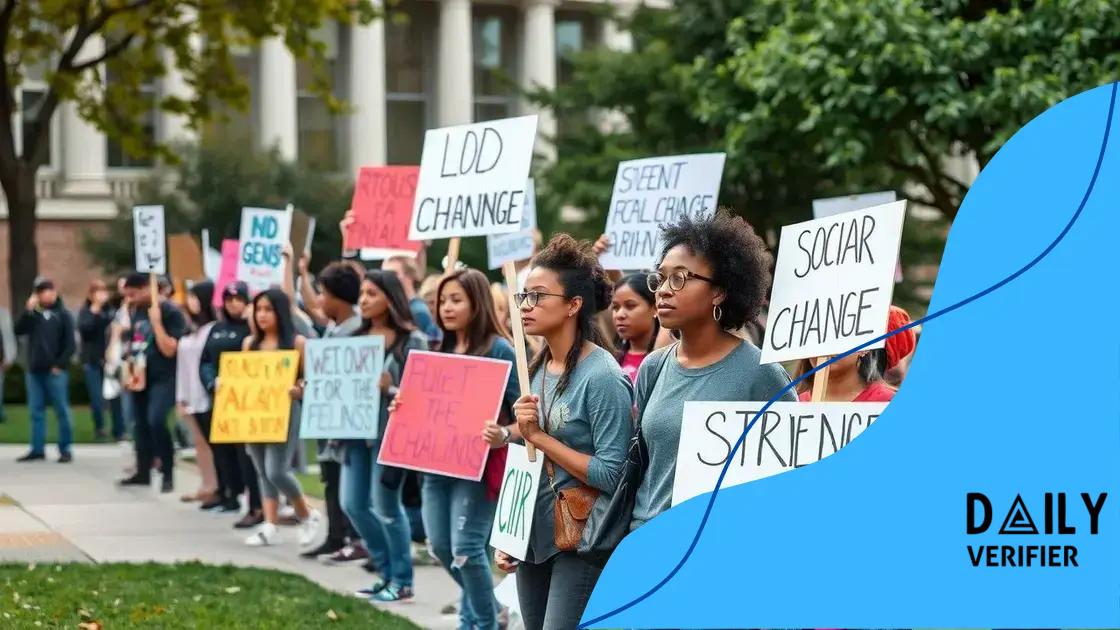Campus protests grow: a closer look at rising movements

Campus protests grow as students increasingly engage with global issues like social justice and climate change, using technology and social media to organize and amplify their voices effectively.
Campus protests grow as students voice their opinions on critical social issues. Have you noticed a surge in activism at universities? Let’s unpack the reasons behind this rise.
Understanding the rise of campus protests
The rise of campus protests has become a significant topic of discussion. Understanding why students are taking to the streets is essential to grasp the current climate of activism. Factors like social justice, climate change, and mental health have pushed students to express their views.
Key Factors Influencing Protests
Many elements contribute to increasing campus activism. Students see themselves as a vital part of the larger societal conversation. They are not just passive observers; they engage deeply with the issues.
- Social Media Influence: Platforms help amplify students’ voices.
- Paid Advocacy: National organizations support various causes.
- Global Events: Situations worldwide motivate local actions.
- Community Engagement: Students want to make a tangible difference.
The political landscape plays a critical role as well. When policies or actors challenge their values, students feel compelled to respond. This generation is savvy; they understand the power of their influence.
Emotional Connectivity
Students are increasingly connecting emotionally with issues they advocate for. This emotional engagement encourages many to find their voices, speak out, and foster change. Recognizing the struggles of others is crucial for mobilizing support.
As they unite for causes they care about, students build networks that influence future activism. The desire for change fuels this passionate engagement, making campus protests not just a trend but a movement of empowerment.
In light of these factors, understanding the dynamics of campus protests offers insight into student motivations and aspirations. Their voices matter, and the change they advocate for resonates far beyond campus boundaries.
Key issues fueling student activism
Identifying the key issues fueling student activism is crucial in understanding why campus protests are gaining momentum. Students today are more aware of social, political, and environmental challenges than ever before. Their activism is shaped by their experiences and the world around them.
Social Justice
One of the driving forces behind student protests is the quest for social justice. Issues such as racial equality, gender rights, and LGBTQ+ representation have become central to many movements. Students are actively fighting against discrimination and advocating for equal rights across various demographics.
- Racial Equality: Ongoing discussions about systemic racism inspire many students to take action.
- Gender Rights: The fight for women’s rights and equity remains a crucial topic.
- LGBTQ+ Advocacy: Supporting and empowering LGBTQ+ individuals is essential for many activists.
These topics resonate not just on campus, but across entire communities. They inspire students to unite under a common cause and work towards meaningful changes.
Climate Change
Another significant factor is the concern for climate change. Many students feel a sense of urgency regarding environmental issues. They recognize that their future is at stake, and this motivates them to demand action from leaders and institutions. The school climate strikes organized by young activists have garnered global attention, emphasizing the need for immediate change.
Students also connect their climate activism to social justice, understanding that marginalized communities are often the most affected by environmental issues. This intersectionality enriches their protests and broadens their message.
As students tackle these key issues, they become more than just participants in protests; they evolve into leaders advocating for a better tomorrow. Their voices, driven by passion and knowledge, become powerful tools for change and influence.
Impact of social media on protest movements

The impact of social media on protest movements has changed how activism occurs today. Social media platforms allow students to connect quickly, share ideas, and organize events. This technology has made it easier than ever to spread awareness about important issues.
Instant Communication
One significant advantage of social media is instant communication. Students can share messages and updates in real time, reaching a wide audience within moments. This rapid sharing creates an immediate response to events happening around the world.
- Mobilization: Quick organization of protests and rallies.
- Awareness: Raising awareness about different social issues.
- Community Building: Connecting like-minded individuals.
- Resource Sharing: Distributing information and useful resources.
When students see something that inspires them, they can easily use their phones to share those feelings and mobilize others. This immediacy often leads to larger turnouts at events, as individuals feel a part of a bigger movement.
Visual Storytelling
Social media also highlights visual storytelling. Through images, videos, and live streams, students can showcase the power of their movements. A single photo from a protest can capture emotions and experiences that resonate with others, drawing them into the cause. Many hashtags bring people together online, allowing for broader conversations surrounding these issues.
However, it’s vital to approach social media thoughtfully. Misinformation can easily spread, leading to confusion and disruption within movements. Students often have to navigate through false information while trying to promote their cause, emphasizing the need for critical thinking and verification.
Thus, the influence of social media on protest movements is undeniable. It serves as a powerful tool for connection, awareness, and advocacy, thus shaping the future of activism for a new generation of students.
Successful examples of campus activism
Many successful examples of campus activism illustrate how students can make a difference. These movements not only shape policies but also influence societal norms. Understanding these examples can inspire new activists to take action.
Student-Led Walkouts
One prominent form of activism is the student-led walkouts. These events often unite students around critical issues such as gun control, climate change, and social justice. At numerous schools across the country, students have walked out of classrooms to protest inaction on these urgent concerns.
- National School Walkout: Triggered by gun violence, students around the nation left their schools to demand stricter gun laws.
- Climate Strikes: Inspired by Greta Thunberg, many students protested to raise awareness about climate change and its impact on their future.
- Gender Equity Rallies: Events promoting equal pay and women’s rights have seen massive participation from students advocating change.
These actions show the power of collective voices. When students join together, they can catch the attention of policy-makers and the media.
Campus Organizations
In addition to walkouts, students have formed organizations dedicated to specific causes. For instance, groups focused on racial justice, mental health awareness, and sustainability have mobilized students to address pressing concerns. These organizations create safe spaces where students can discuss issues and develop strategies for change.
For example, the Black Lives Matter movement has a strong presence on many campuses, providing education about racial injustices. This fosters dialogue and action among students, ensuring that their voices are heard. By establishing organizations, students cultivate a sense of community that empowers their activism.
Through these successful examples, it becomes evident that student activism is a powerful force for change. The creativity, passion, and determination of students reflect a commitment to creating a brighter future.
Future of student protests on campuses
The future of student protests on campuses looks promising as new generations of activists emerge. Students are becoming increasingly aware of global issues and are willing to take action. This trend points to a growing culture of advocacy and civic engagement within educational institutions.
Increased Global Awareness
As students gain access to information from around the world, their perspectives broaden. The impact of international events makes them feel connected to global movements. They are not just focused on local issues; they want to advocate for change that affects humanity.
- Global Climate Action: Students are likely to become even more involved in addressing climate change.
- Social Movements: Future activism will include more intersectional approaches, tackling various social justice issues concurrently.
- Collaborative Campaigns: Students may work together across borders to promote shared goals.
Digital platforms facilitate these global connections. As a result, we can expect to see coordination of efforts on a larger scale, with students leading the charge.
Integration of Technology
The integration of technology into activism will also shape the future of student protests. Social media and digital tools make it easier for students to organize and mobilize. This advancement encourages real-time updates and immediate responses to issues.
Future movements will likely utilize technology in creative ways. For instance, virtual reality experiences can help people understand complex issues better. Likewise, livestreaming events enables wider reach and engagement.
As technology continues to advance, student activism will adapt. Movements could harness new tools and platforms to increase their visibility and effectiveness.
Overall, the future of student protests on campuses will be characterized by greater awareness, stronger global ties, and innovative use of technology. These elements will help create an environment where students feel empowered to enact change.
In conclusion, the landscape of student protests is evolving rapidly. With a strong commitment to social change, students are becoming increasingly aware of important global issues. Their activism, powered by technology and a collective sense of purpose, is leading to significant movements on campuses. As we look forward, we can expect these young activists to continue making impactful changes that resonate far beyond their campuses.
FAQ – Frequently Asked Questions about Student Protests and Activism
What are the main issues driving student protests today?
Key issues include social justice, climate change, and mental health awareness, as students become more engaged with global challenges.
How does social media influence student activism?
Social media allows for instant communication and mobilization, enabling students to organize events and share their messages widely.
What are some successful examples of student activism?
Examples include student-led walkouts for gun control and climate strikes inspired by global movements, showcasing the power of collective action.
What does the future hold for student activism?
The future looks bright, with increasing global awareness, integration of technology, and strong community engagement fueling meaningful changes.






